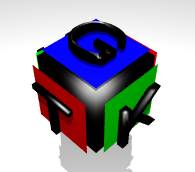|
|
|
| This document is available in: English Castellano Deutsch Francais Italiano Nederlands Russian Turkce |

by Özcan Güngör <ozcangungor(at)netscape.net> About the author: I use Linux since 1997. Freedom, flexibility and opensource. These are the properties I like. Content: |
GUI Programming with GTK - part 2
Abstract: In this article, we will discuss boxes and tables. With these, we will be able to locate components in a proper order on windows. In order to understand these articels, you should know the followings about C programming language:
|
Packing componenets means to locate components in proper order on windows. One of the ways to do this in GTK is using boxes. Main idea behind the boxes is to pack the components ordered vertically or horzontally. There are two types of boxes: Horizontal boxes and vertical boxes. Let's explain these types:
In this box type, components are packed horizontally. The following function is used to create a horizontal box.
gtk_widget *box; box=gtk_hbox_new(gboolean homogenous, gint spacing);
where the parameter homogeneous is used to define whether components are distributed homogenously or not: if it is TRUE,then components are filling up the whole box such that there is equal distance between them and if it is FALSE, then the components are packed side by side. spacing is used for setting the mimimun amount of space between components.
In this box type, components are packed vertically. The following function is used to create a vertical box:
gtk_widget *box; box=gtk_vbox_new(gboolean homogenous, gint spacing);
Parameters in this function have the meaning as in the horizontal box function.
Adding componenets can be done in two ways: The first one is:
gtk_box_pack_start(GtkBox *box,GtkWidget *child,
gboolean expand, gboolean fill, guint padding);
Using this function we can add components into a box.
(on the left side for a horizontal box or at the top of a vertical box)
box is
the box we want to add a component to. child is the
component to be added. expand is used to expand the
size of the component such that it uses all space if possible.
padding is to add additional space on the left and right.
The complementary function to gtk_box_pack_start is gtk_box_pack_end:
gtk_box_pack_end(GtkBox *box,GtkWidget *child,
gboolean expand, gboolean fill, guint padding);
This function lets us add components at the end (right or bottom) of the box. The
parameters have the same meaning as in the previous function.
To add a box onto a window, the following function is used:
gtk_container_add (GtkContainer *container,GtkWidget *component);container is the window that the box will be added to, component is the box to be added. For expample, to add the box we have created above to window, following command is used:
gtk_container_add(GTK_CONTAINER(window),box);
gtk_box_set_homogeneous (GtkBox *box, gboolean homogenous); gtk_box_set_spacing(GtkBox *box, gint spacing);The first function above is used to change the property homogenous of a box and the second function is used to change the size of the space of a box. box is the box to be changed.
gtk_box_set_child_packing(GkBox *box,GtkWidget *shild,
gboolean expand, gboolean fill, guint padding,
GtkPackType packingtype);
This function redefines the properties of an already packed
component. Parameters have the same meaning as in the function
gtk_box_pack_start. packingtype can be GTK_PACK_START or
GTK_PACK_END. GTK_PACK_START causes the component be packed in
the beginning of the box if the component is pack using the
function gtk_pack_end. GTK_PACK_END causes the component be
packed at the end of the box if the component is packed using
the function gtk_pack_start.
To understand better what has explained here, try kutular.c.
Tables, like in HTML code, help us to fix components in cells. For this, it is enough to create a table which has enough rows and columns. Then we can locate a component in a cell or cell groups (allowed only for cells that are side by side). To create a table, following function is used:
GtkWidget *table; GtkWidget* gtk_table_new(guint row, guint column, gboolean homogenous);row is the number of rows, column is the number of columns.homogenous is used to distribute the components homogenously.
The following function is used to add a component to a table:
void gtk_table_attach (GtkTable *table, GtkWidget *child,
guint left_attach, guint left_attach, guint top_attach,
guint bottom_attach, GtkAttachOptions xoptions,
GtkAttachOptions yoptions, guint xpadding, guint ypadding);
table is the table where components will be added and
child is the component to be added. left_attach
is the number of the cell on the left that the component will
be put into. right_attach is the number of the cell on the
right that the component will be put into. top_attach is
the number of the cell at the top that the component will be
located in and bottom_attach is the number of the cell at
the bottom that the component will be located in. Components may
cover in more than one cell.
xoptions and yoptions can get three different vaules: GTK_FILL, GTK_EXPAND, GTK_SHRINK. GTK_FILL causes the component to fill the whole cell(s). GTK_EXPAND causes the component be located in the center of the cell(s) and GTK_SHRINK causes the component shrink into the cell(s) dimesions if the component is larger than cell(s).xoptions makes these changes only in x axis and yoptions makes only y axis.
xpadding puts space on the left and rigth of the component along x axis where ypadding does it along y axis.
Here is an example code:
#include <gtk/gtk.h>
void delete_event( GtkWidget *widget,GdkEvent *event,gpointer data )
{
gtk_main_quit ();
}
int main( int argc,char *argv[] )
{
GtkWidget *window;
GtkWidget *button;
GtkWidget *table;
gtk_init (&argc, &argv);
window = gtk_window_new (GTK_WINDOW_TOPLEVEL);
gtk_signal_connect (GTK_OBJECT (window), "delete_event",
GTK_SIGNAL_FUNC (delete_event), NULL);
table = gtk_table_new (2, 2, TRUE);
gtk_container_add (GTK_CONTAINER (window), table);
button = gtk_button_new_with_label ("button 1");
gtk_table_attach(GTK_TABLE(table), button, 0, 1, 0, 2,GTK_SHRINK,
GTK_SHRINK,0,0);
gtk_widget_show (button);
button = gtk_button_new_with_label ("button 2");
gtk_table_attach (GTK_TABLE(table), button, 1, 2, 1, 2,
GTK_SHRINK,GTK_SHRINK,0,0);
gtk_widget_show (button);
button = gtk_button_new_with_label ("button 3");
gtk_table_attach (GTK_TABLE(table), button, 1, 2, 0, 1,
GTK_SHRINK,GTK_SHRINK,0,0);
gtk_widget_show (button);
gtk_widget_show (table);
gtk_widget_show (window);
gtk_main ();
return 0;
}
As gtk_table attach has a lot of parameters, a new and short function is created: gtk_table_attach_defaults. This function does the same job but with fewer parameters.
void gtk_table_attach_defaults (GtkTable *table,GtkWidget *child,
guint left_attach, guint right_attach, guint top_attach,
guint bottom_attach);
Here the parameters have the same meaning.xoptions and
yoptions have the value GTK_FILL|GTK_EXPAND.
xpadding and ypadding have the vaule 0.
The following function is used to change the number of rows and columns of a existing table:
void gtk_table_resize(GtkTable *table, guint rows, guint columns);
Using the following functions, you can change the spacing value of a row or a column:
void gtk_table_set_row_spacing (GtkTable *table, guint row,
guint spacing);
void gtk_table_set_col_spacing (GtkTable *table, guint column,
guint spacing);
The following functions change the spacing values of whole rows or columns:
void gtk_table_set_row_spacings (GtkTable *table, guint spacing); void gtk_table_set_col_spacings (GtkTable *table, guint spacing);
The following function changes the homogenous value of a existing table:
void gtk_table_set_homogeneous (GtkTable *table, gboolean homogenous);
In this article, we have learnt the means for packing components and then we looked at functions to some properties of boxes and tables. I am always happy to get questions, comments and ideas from readers. Just send me an e-mail....
|
|
Webpages maintained by the LinuxFocus Editor team
© Özcan Güngör, FDL LinuxFocus.org |
Translation information:
|
2003-07-03, generated by lfparser version 2.40